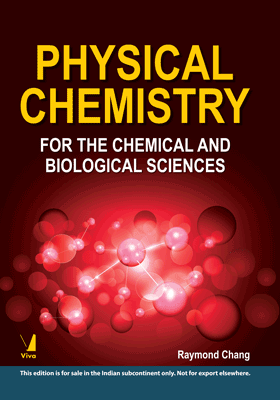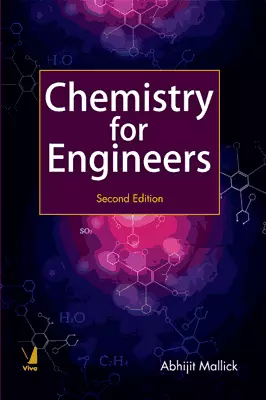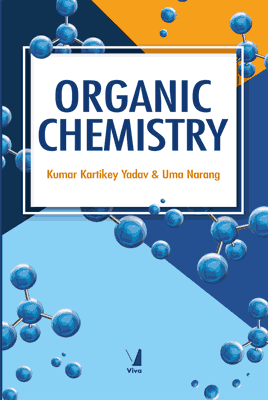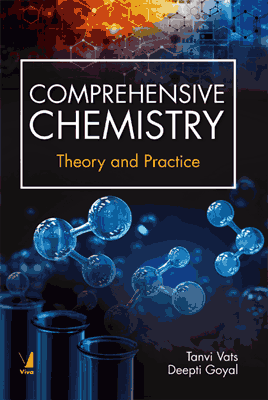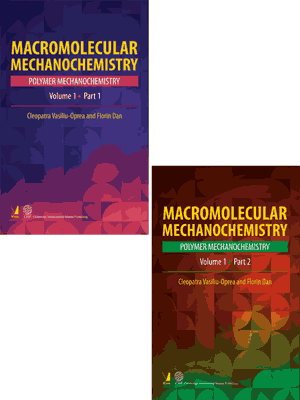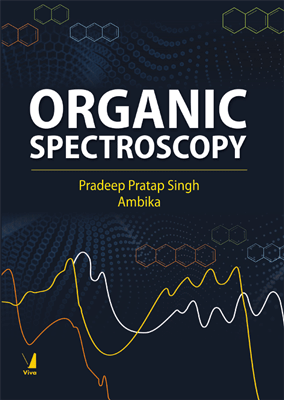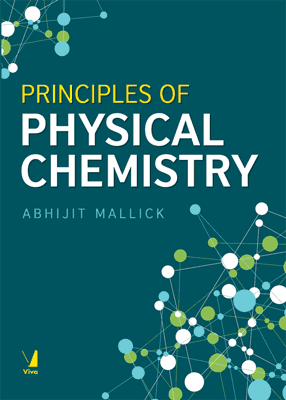Physical Chemistry For the Chemical and Biological Sciences
Physical Chemistry For the Chemical and Biological Sciences
₹895.50 ₹995.00 Save: ₹99.50 (10%)
Go to cartISBN: 9789386105554
Bind: Paperback
Year: 2016
Pages: 1040
Size: 171 x 241 mm
Publisher: University Science Books
Published in India by: Viva Books
Exclusive Distributors: Viva Books
Sales Territory: India, Nepal, Pakistan, Bangladesh, Sri Lanka
Reviews:
“This book offers an alternative approach to physical chemistry that is particularly well suited for those who want to pursue a course of study more focused on the biological sciences.”
-Journal of Chemical Education
“A distinct and excellent publication worth recommending to biological chemists ... l have learnt something new about biology, [the book] is very refreshing in its aims and clarity.”
- The Times Higher
Description:
Hailed by advance reviewers as “a kinder, gentler P. Chem. text,” this book meets the needs of a full-year course in physical chemistry. It is an ideal choice for classes geared toward premedical and life sciences students. Or as stated in a May 2001 review in Journal of Chemical Education, “this text meets these students where they are and opens the door to physical chemistry from a perspective they can appreciate.” Physical Chemistry for the Chemical and Biological Sciences offers a wealth of applications to chemical and biological problems, numerous chapter-ending exercises, and an accompanying solutions manual. Well known for his clear writing and careful pedagogical approach, Raymond Chang has developed yet another masterpiece in chemical education.
Key Features:
- a student-oriented, highly readable text
- traditional and flexible organization
- a functional and pleasing two-color format
- many worked examples in text
- @1000 chapter-ending problems
- an overview of key equations in each chapter
- a glossary of key terms
- answers provided to even-numbered computational problems
Target Audience:
Students and Academicians of Physical Chemistry, Life Sciences and Pre-medical Studies.
Contents:
Preface
Chapter 1: Introduction • Nature of Physical Chemistry • Units • Force • Pressure • Energy • Atomic Mass, Molecular Mass, and the Chemical Mole
Chapter 2: The Gas Laws • Some Basic Definitions • An Operational Definition of Temperature. • Boyle's Law • Charles? and Gay-Lussac's Law • Avogadro's Law • The Ideal Gas Equation • Dalton's Law of Partial Pressures • Real Gases • The van der Waals Equation • The Virial Equation of State • Condensation of Gases and the Critical State Problems
Chapter 3: Kinetic Theory of Gases? The Model • Pressure of a Gas • Kinetic Energy and Temperature • The Maxwell Distribution Laws • Molecular Collisions and the Mean Free Path • Gas Viscosity • Graham's Laws of Diffusion and Effusion • Equipartition of Energy • Appendix 3.1 Derivation of Equation 3.24 • Appendix 3.2 Total and Partial Differentiation • Problems
Chapter 4: The First Law of Thermodynamics • Work and Heat • Work • Heat • The First Law of Thermodynamics • Enthalpy • A Closer Look at Heat Capacities • Gas Expansion • Isothermal Expansion • Adiabatic Expansion • Thermochemistry • Standard Enthalpy of Formation • Dependence of Enthalpy of Reaction on Temperature • Bond Energies and Bond Enthalpies • Bond Enthalpy and Bond Dissociation Enthalpy • Appendix . Exact and Inexact Differentials • Problems
Chapter 5: The Second Law of Thermodynamics? Spontaneous Process • Entropy • Statistical Definition of Entropy • Thermodynamic Definition of • Entropy • The Camot Heat Engine • Thermodynamic Efficiency • The Entropy Function • Refrigerators, Air Conditioners, and Heat Pumps • The Second Law of Thermodynamics • Entropy Changes • Entropy Change due to Mixing of Ideal Gases • Entropy Change due to Phase Transitions • Entropy Change due to Heating • The Third Law of Thermodynamics • Third-Law or Absolute Entropies • Entropy of Chemical Reactions • Residual Entropy • Appendix: Statements of the Second Law of Thermodynamics • Problems
Chapter 6: Gibbs and Helmholtz Energies and Their Applications • Gibbs and Helmholtz Energies • Meaning of Helmholtz and Gibbs Energies • Helmholtz Energy • Gibbs Energy • Standard Molar Gibbs Energy of Formation (G) • Dependence of Gibbs Energy on Temperature and Pressure • Dependence of G on Temperature • Dependence of G on Pressure • Gibbs Energy and Phase Equilibria • The Clapeyron and Clausius-Clapeyron Equations • Phase • Diagrams • The Phase Rule • Thermodynamics of Rubber Elasticity • Appendix . Some Thermodynamic Relationships • Appendix . Derivation of the Phase Rule • Problems
Chapter 7: Nonelectrolyte Solutions? Concentration Units • Percent by Weight • Mole Fraction (x) • Molarity (M) • Molality (m) • Partial Molar Quantities • Partial Molar Volume • Partial Molar Gibbs Energy • The Thermodynamics of Mixing • Binary Mixtures of Volatile Liquids • Boiling-Point Elevation • Osmotic Pressure • Real Solutions • The Solvent Component • The Solute Component • Phase Equilibria of Two-Component Systems • Distillation • Solid-Liquid Equilibria • Colligative Properties • Vapor-Pressure Lowering • Freezing-Point Depression • Problems
Chapter 8: Electrolyte Solutions • Electrical Conduction in Solution • Some Basic Definitions • Degree of Dissociation • Ionic Mobility • Applications of Conductance Measurements • A Molecular View of the Solution Process • Thermodynamics of Ions in Solution • Enthalpy, Entropy, and Gibbs Energy of Formation of Ions in Solution • Ionic Activity • Debye-Hiickel Theory of Electrolytes • The Salting-In and Salting-Out Effects • Colligative Properties of Electrolyte Solutions • The Donnan Effect • Biological Membranes • Membrane Transport • Appendix 8.1: Notes on Electrostatics • Appendix 8.2: The Donnan Effect Involving Proteins Bearing Multiple Charges • Problems
Chapter 9: Chemical Equilibrium? Chemical Equilibrium in Gaseous Systems • Ideal Gases • Real Gases • Reactions in Solution • Heterogeneous Equilibria • The Influence of Temperature, Pressure, and Catalysts on the Equilibrium Constant • The Effect of Temperature • The Effect of Pressure • The Effect of a Catalyst • Binding of Ligands and Metal Ions to Macromolecules • One Binding Site per Macromolecule • nEquivalent Binding Sites per Macromolecule • Equilibrium Dialysis • Bioenergetics • The Standard State in Biochemistry • ATP--?The Currency of Energy • Principles of Coupled Reactions • Glycolysis • Some Limitations of Thermodynamics • Appendix 9.1: The Relationship Between Fugacity and Pressure? • Appendix 9.2: The Relationships Between K1 and K2 and the Intrinsic Dissociation • Constant K • Problems
Chapter 10: Electrochemistry • Electrochemical Cells • Single-Electrode Potential • Thermodynamics of Electrochemical Cells • The Nernst Equation • Temperature Dependence of EMF • Types of Electrodes • Metal Electrodes • Gas Electrodes • Metal Insoluble Salt • Electrodes • The Glass Electrode • Electrodes • Types of Electrochemical Cells • Concentration Cells • Fuel Cells • Applications of EMF Measurements • Determination of Activity Coefficients • Potentiometric Titration of Redox Reactions • Biological Oxidation • The Chemiosmotic Theory of Oxidative Phosphorylation • Membrane Potential • The Goldman Equation • The Action Potential • Problems
Chapter 11: Acids and Bases • Definitions of Acids and Bases • Dissociation of Acids and Bases • The Ion Product of Water and the pH Scale • The Relationship Between the Dissociation Constant of an Acid and Its Conjugate Base • Salt Hydrolysis • Acid-Base Titrations • Acid-Base Indicators • Diprotic and Polyprotic Acids • Amino Acids • Dissociation of Amino Acids • The Isoelectric Point (pI) • Buffer Solutions • The Effect of Ionic Strength and Temperature on Buffer Solutions • Preparing a Buffer Solution With a Specific pH • Buffer Capacity • Maintaining the pH of Blood • Appendix . A More Exact Treatment of Acid-Base Equilibria • Problems
Chapter 12: Chemical Kinetics • Reaction Rate • Reaction Order • Zero-Order Reactions • First-Order Reactions • Second-Order Reactions • Determination of Reaction Order • Molecularity of a Reaction • Unimolecular Reactions • Bimolecular Reactions • Termolecular Reactions • More Complex Reactions • Reversible Reactions • Consecutive Reactions • Chain Reactions • The Effect of Temperature on Reaction Rates • The Arrhenius Equation • Potential-Energy Surfaces? • Theories of Reaction Rates • Collision Theory • Transition-State Theory • Thermodynamic Formulation of Transition-State Theory • Isotope Effects in Chemical Reactions • Reactions in Solution • Fast Reactions in Solution • The Flow Method • The Relaxation Method • Oscillating Reactions • Appendix 12.1 Derivation of Equation . • Appendix 12.2 Derivation of Equation • Problems
Chapter 13: Enzyme Kinetics • General Principles of Catalysis • Enzyme Catalysis • The Equations of Enzyme Kinetics • Michaelis-Menten Kinetics • Steady-State Kinetics • The Significance of
KMand Vmax? Chymotrypsin: A Case Study • Multisubstrate Systems • The Sequential Mechanism • The Nonsequential or ?Ping-Pong? Mechanism • Enzyme Inhibition • Reversible Inhibition • Irreversible Inhibition • Allosteric Interactions • Oxygen Binding to Myoglobin and Hemoglobin • The Hill Equation • The Concerted Model • The Sequential Model • Conformational Changes in Hemoglobin Induced by Oxygen Binding • pH Effects on Enzyme Kinetics • Appendix 13.1 Kinetic Analysis of the Hydrolysis of p-Nitrophenyl Trimethylacetate Catalyzed by Chymotrypsin • Appendix 13.2 Derivations of Equations 13.7 and 13.19 • Appendix 13.3 Derivation of Equation 13.32. • Problems
Chapter 14: Quantum Mechanics and Atomic Structure? The Wave Theory of Light • Planck's Quantum Theory • The Photoelectric Effect • Bohr's Theory of the Hydrogen Emission Spectrum • de Broglie's Postulate • The Heisenberg Uncertainty Principle • The Schrodinger Wave Equation • Particle in a One-Dimensional Box • Electronic Spectra of Polyenes • Quantum-Mechanical Tunneling • The Schr?dinger Wave Equation for the Hydrogen Atom • Atomic Orbitals • Many-Electron Atoms and the Periodic Table • Electron Configurations • Variations in Periodic Properties • Problems
Chapter 15: The Chemical Bond • Lewis Structures • Valence Bond Theory • Hybridization of Atomic Orbitals • Methane (CH4) • Ethylene (C2H4) • Acetylene (C2H4) • Electronegativity and Dipole Moment • Electronegativity • Dipole Moment • Molecular Orbital Theory • Diatomic Molecules • Homonuclear Diatomic Molecules of the Second-Period Elements • Heteronuclear Diatomic Molecules of the First- and Second-Period Elements • Resonance and Electron Delocalization • The Peptide Bond • Coordination Compounds • Crystal Field Theory • Molecular Orbital Theory • Valence Bond Theory • Coordination Compounds in Biological Systems • Problems
Chapter 16: Intermolecular Forces • Intermolecular Interactions • The Ionic Bond • Types of Intermolecular Forces • Dipole-Dipole Interaction • Ion-Dipole Interaction • Ion-Induced Dipole and Dipole-Induced Dipole Interactions • Dispersion, or London, Interactions • Repulsive and Total • Interactions • The Role of Dispersion Forces in Sickle-Cell Anemia • The Hydrogen Bond • The Structure and Properties of Water • The Structure of Ice • The Structure of Water • Some Physiochemical Properties of Water • Hydrophobic Interaction • Problems
Chapter 17: Spectroscopy • Vocabulary • Absorption and Emission • Units • Regions of the Spectrum • Line Width • Resolution • Intensity • Selection Rules • Signal-to-Noise Ratio • The Beer-Lambert Law • Microwave Spectroscopy • Infrared Spectroscopy • Simultaneous Vibrational and Rotational Transitions • Electronic Spectroscopy • Organic Molecules • Transition Metal Complexes • Molecules that Undergo Charge-Transfer Interactions • Application of the Beer-Lambert Law • Nuclear Magnetic Resonance Spectroscopy • The Boltzmann Distribution • Chemical Shifts • Spin Coupling • NMR and Rate Processes • NMR of Nuclei Other Than H • Electron Spin Resonance Spectroscopy • Fluorescence and Phosphorescence • Fluorescence • Phosphorescence • Lasers • Properties and Applications of Laser Light • Appendix 12.1 Fourier-Transform Spectroscopy • Problems
Chapter 18: Molecular Symmetry and Optical Activity? Symmetry of Molecules • Proper Rotation Axis • Plane of Symmetry • Center of • Symmetry • Improper Rotation Axis • Molecular • Symmetry and Dipole Moment • Molecular Symmetry and Optical • Activity • Polarized Light and Optical Rotation • Optical Rotatory Dispersion and Circular Dichroism • Problems
Chapter 19: Photochemistry and Photobiology? Introduction • Thermal Versus Photochemical Reactions • Primary Versus • Secondary Processes • Quantum Yields • Measurement of Light Intensity • Action Spectrum • Earth's Atmosphere • Composition of the Atmosphere • Regions of the • Atmosphere • Residence Time • The Greenhouse Effect • Photochemical Smog • Formation of Nitrogen Oxides • Formation of O3 Formation of Hydroxyl Radical • Formation of Other Secondary Pollutants • Harmful Effects and Prevention of Photochemical Smog • The Essential Role of Ozone in the Stratosphere • Formation of the Ozone Layer • Destruction of Ozone • Polar Ozone Holes • Ways to Curb Ozone Depletion • Photosynthesis • The Chloroplast • Chlorophyll and Other Pigment Molecules • The Reaction Center • ? Photosystems I and • II • Dark Reactions • Vision • Structure of Rhodopsin • Mechanism of Vision • Rotation About the C=C Bond • Biological Effects of Radiation • Sunlight and Skin Cancer • Photomedicine • Light-Activated Drugs • Problems
Chapter 20: The Solid State • Classification of Crystal Systems • The Bragg Equation • Structural Determination by X-ray Diffraction • The Powder Method • Determination of the Crystal Structure of NaCl • The Structure Factor • Neutron Diffraction • Types of Crystals • Metallic Crystals • Ionic Crystals • Covalent Crystals • Molecular Crystals • Appendix 20.1 Derivation of Equation . • Problems
Chapter 21: The Liquid State • Structure of Liquids • Viscosity • Surface Tension • The Capillary-Rise Method • Surface Tension in the Lungs Diffusion • Rick's Laws of Diffusion • Liquid Crystals • Thermotropic Liquid Crystals • Lyotropic Liquid Crystals • Appendix 21.1 Derivation of Equation • Problems
Chapter 22: Macromolecules • Methods for Determining Size, Shape, and Molar Mass of Macromolecules • Molar Mass of Macromolecules • Sedimentation in the Ultracentrifuge • Viscosity • Electrophoresis • Structure of Synthetic Polymers • Configuration and Conformation • The Random-Walk • Model • Structure of Proteins and DNA • Proteins • DNA • Protein Stability • Hydrophobic Interaction • Denaturation • Protein • Folding • Appendix 21.1 DNA Fingerprinting • Problems
Chapter 23: Statistical Thermodynamics? Macrostates and Microstates • The Boltzmann Distribution Law • The Partition Function • Molecular Partition Function • Translational Partition Function • Rotational Partition Function • Vibrational Partition Function • Electronic Partition Function • Thermodynamic Quantities from Partition Functions • Internal Energy and Heat Capacity • Entropy • Chemical Equilibrium • Transition-State Theory • Appendix 23.1 Justification of Q = qN IN! for Indistinguishable Molecules • Problems
Appendix A: Review of Mathematics and Physics • Appendix B: Thermodynamic Data • Glossary • Answers to Even-Numbered Computational Problems • Index
About the Author:
Raymond Chang was born in Hong Kong and grew up in Shanghai and Hong Kong, China. He received his B.Sc. degree in chemistry from London University, England and his Ph.D. in physical chemistry from Yale University. After doing postdoctoral research at Washington University and teaching for a year at Hunter College of the City University of New York, he joined the chemistry department at Williams College. Chang has served on the American Chemical Society Examination Committee and the Graduate Record Examination (GRE) Committee. He is an editor of The Chemical Educator and has authored books on general chemistry and spectroscopy.
